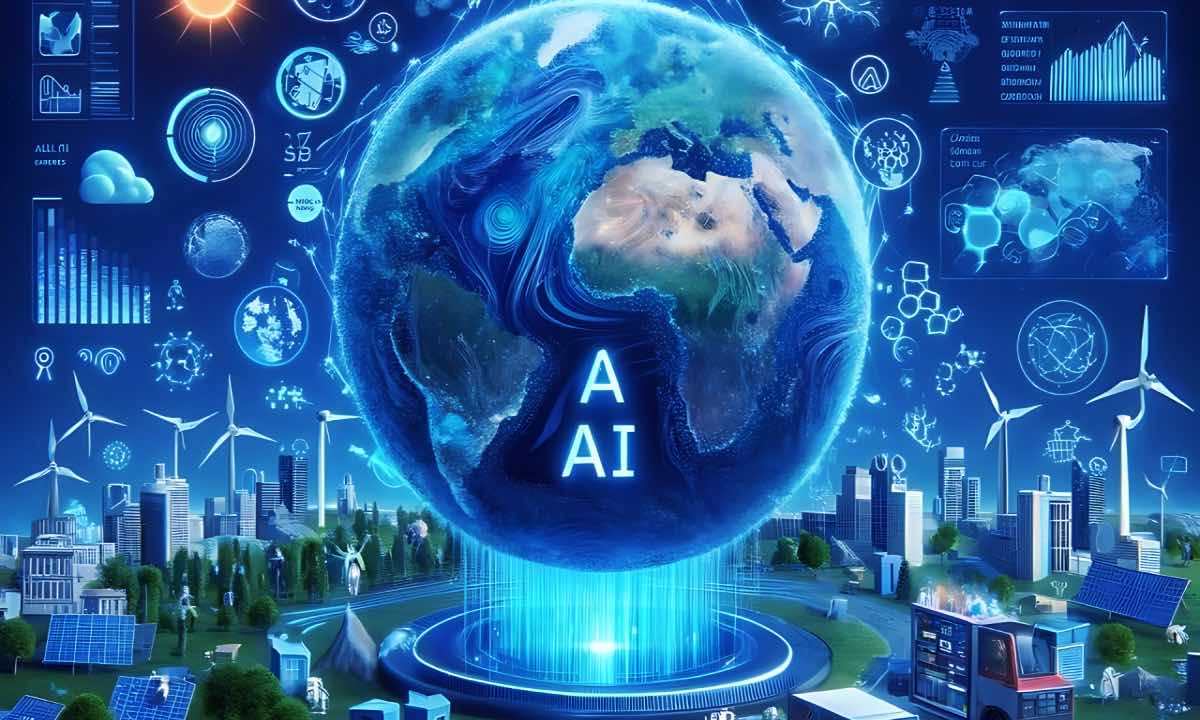
OR
#OPINION
Combating Climate Change while Managing Energy Use with AI
Published On: July 23, 2024 08:30 AM NPT By: Rastra Dhoj Karki

In Ireland, data centers consume 30% of the nation's power
As the world faces the escalating impacts of climate change, artificial intelligence (AI) emerges as a powerful ally in the battle to mitigate environmental damage. AI offers solutions to the most pressing climate challenges by implementing predictive analytics that forecast weather patterns to optimize renewable energy sources. However, this technology comes with its own set of complications. The energy required to power these technologies is substantial and growing, raising concerns about the carbon pollution of data centers using AI algorithms.
It is time to consider the dual role of AI in climate change mitigation and the significant energy demands it imposes. By exploring the promise and challenges of AI, I aim to highlight the need for sustainable development in harnessing AI's potential for a greener future while addressing its energy consumption concerns.
Artificial intelligence has revolutionized climate modeling, providing scientists and environmentalists with refined tools to predict climate patterns and extreme weather events. Advanced AI algorithms analyze vast datasets from satellites, weather stations, and ocean buoys, offering insights into future climate scenarios with unprecedented accuracy. For instance, machine learning models can identify subtle patterns and correlations in historical climate data, enhancing our understanding of climate dynamics. These predictive analytics are crucial for preparing for and mitigating the impacts of natural disasters, such as hurricanes, floods, and droughts. AI also plays a pivotal role in optimizing the production and distribution of renewable energy.
Machine learning algorithms can forecast energy production from renewable sources like solar and wind with high precision, allowing for more efficient grid management and energy storage. For example, Google's DeepMind has used AI to increase the energy output of wind farms by predicting wind patterns and adjusting turbine settings accordingly. Furthermore, AI-driven smart grids can balance supply and demand more effectively, reducing energy waste and improving the integration of renewable energy into the existing power infrastructure. These improvements boost the efficiency of renewable energy sources and contribute to reducing greenhouse gas emissions.
AI is transforming the field of environmental monitoring by providing real-time insights into ecosystems. Advanced models analyze data from satellite imagery, drones, and sensor networks to detect deforestation, track pollution levels, and monitor wildlife populations. For instance, ML algorithms can process vast amounts of satellite data to identify illegal logging activities in rainforests, enabling quicker response actions.
Similarly, AI-driven systems can monitor air and water quality, alerting authorities to pollution spikes that require immediate intervention. These technologies are crucial for tracking and responding to environmental changes effectively and efficiently. AI tech aids in protecting endangered species and preserving natural habitats. Machine learning models analyze data from camera traps, audio sensors, and other monitoring tools to identify and track species in their natural environments, helping conservationists understand animal behavior, migration patterns, and population dynamics.
For example, AI has been used to identify and count endangered species like rhinos and elephants from drone footage, significantly reducing the work and time required for these tasks. Moreover, AI supports habitat restoration projects by predicting the outcomes of different conservation strategies, allowing for more informed decision-making. These applications of AI are essential for advancing global conservation efforts and protecting biodiversity. The rapid advancement and deployment of AI technologies have led to a significant increase in energy consumption.
Data centers consume vast amounts of electricity, contributing to a substantial carbon footprint. Studies estimate that training a single AI model can emit as much carbon as five cars over their lifetimes. As AI applications become more complex and widespread, energy demands rise. For instance, natural language processing models like GPT-3 require immense computational power, leading to higher energy usage than traditional data processing tasks. The energy consumption of AI technologies is growing exponentially.
As industries increasingly adopt AI for various applications, from autonomous vehicles to smart cities, the demand for computational resources will surge. Projections indicate that the AI sector could be the leading consumer of global electricity in the coming decades. Addressing this issue requires urgent attention to develop energy-efficient AI technologies and integrate renewable energy sources to mitigate the impact on global energy resources. Efforts are underway to reduce the energy footprint of AI by making algorithms and hardware more energy-efficient, and innovations like quantization, pruning, and hardware accelerators minimize computational requirements.
Dr. Mark van Rijmenam highlights that AI is already in various fields, including healthcare, with DeepMind's AlphaFold predicting protein structures. These advancements are not limited to healthcare but extend to climate change mitigation, where AI helps forecast climate-related dangers. As AI progresses towards superintelligence, it holds potential for global energy management, optimizing resource allocation, and reducing wastage. AI can manage and optimize renewable energy grids, ensuring efficient use and storage of clean energy.
Kate Crawford, an internationally leading AI scholar, emphasizes the enormous computational needs housed in power-hungry data centers. She warns of an impending energy crisis driven by the escalating demands.
Another AI specialist, Sam Young, notes the increasing energy use across various sectors, including AI. He points out that while Europe benefits from shared electricity resources, such efficiencies are lacking elsewhere. In Ireland, data centers consume 30% of the nation's power.
Addressing these challenges involves adopting renewable energy sources and enhancing global cooperation in energy management to support the sustainable growth of AI technologies. AI's potential to address climate change is vast, offering innovative solutions through predictive analytics, environmental monitoring, and renewable energy optimization. These advancements are crucial for mitigating environmental impacts and supporting global conservation efforts. However, the growing energy demands of AI technologies pose a significant challenge.
As highlighted by experts like Dr. Mark van Rijmenam, the benefits of AI in various sectors, including healthcare and climate forecasting, must be balanced against its substantial energy footprint. The move towards AI superintelligence could further strain global energy resources, underscoring the need for sustainable development.
Kate Crawford's insights into the energy-intensive nature of AI computations and data centers, coupled with Sam Young's observations on the broader energy consumption trends, emphasize the urgency of addressing AI's energy requirements. It is essential to invest in energy-efficient technologies and integrate renewable energy sources.
Global cooperation and innovative strategies in energy management are vital to support the sustainable growth of AI. As we look to the future, the promise of AI in creating a more sustainable world is clear. However, achieving this potential requires a concerted effort to balance AI's benefits with its environmental impact, fostering a future where technology and sustainability go hand in hand.
You May Like This

Impact of climate change attributed to dengue cases in mountainous districts in Karnali Province
KARNALI, Oct 1: With the rise in the temperature in mountainous regions due to climate change, dengue cases have been... Read More...

'Death sentence': low-lying nations implore faster action on climate at U.N.
UNITED NATIONS, Sept 23: Faced with what they see as an existential threat, leaders from low-lying and island nations implored... Read More...

If you had the world’s attention for five minutes, what would you say?
Having the whole world’s attention is a big deal—it’s not something most of us get in our entire lives. But... Read More...





Just In
- No best employee award for eighth consecutive year
- NAC blames govt and CAAN for failure to generate profit
- ‘Bribe-seeking’ DSP Shahi suspected of involvement in terrorist activities
- Foreign companies took over Rs 150 billion in dividends from Nepal in eight years
- PM Oli confers awards on 40 civil servants
- Germany to provide Rs 7.5 billion in grant to Nepal
- PM Oli says no immediate prospects for salary increment for civil servants
- Cyclist dies in motorcycle collision in Nawalparasi














Leave A Comment